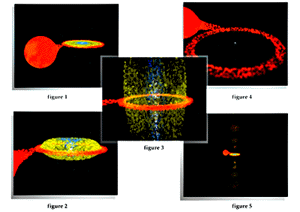Imagine the Universe! News Desk
"Old Faithful" Black Hole Provides Insight into Jet Formation
| 17 August 1998 |
Scientists observing a disk of matter surrounding a black hole in our Galaxy have discovered that the disk is periodically disrupted and hurled outward in opposite directions from the black hole, in jets moving at nearly the speed of light. The black hole replenishes the disk by pulling hot gas from the surface of a nearby "companion" star, and then undergoes another disruption, repeating the sequence at half-hour intervals.
 Credit: NASA |
|
Show me a movie about the "Old Faithful" Black Hole Phenomenon |
Researchers from teams at the California Institute of Technology, Pasadena, CA, the Massachusetts Institute of Technology (MIT), Boston, and NASA's Goddard Space Flight Center, Greenbelt, MD, all worked to correlate the disappearance of X-ray emitting hot gas in the disk with the appearance, shortly thereafter, of rapidly expanding jets. Dr. Ronald Remillard of MIT and Dr. Jean Swank of Goddard are discovered the X-ray behavior using data from NASA's Rossi X-ray Timing Explorer (RXTE); Dr. Stephen Eikenberry of Caltech used infrared observations made at Mt. Palomar, CA to demonstrate that when the X-rays from the disk vanish, the jets suddenly appear.
The X-rays from the disk disappear almost completely every half hour. About five minutes later, they return again. Very shortly after the X-rays vanish, jets appear at infrared and radio wavelengths. Since X-ray emitting hot gas in the disk disappears during these episodes, it is believed that the matter in the disk must have escaped, probably flung out in the jets. As the black hole pulls more gas from its companion star, the disk appears again (along with the X-rays) and the cycle starts over. "The system behaves like the celestial version of Old Faithful," notes Dr. Craig Markwardt, a researcher working with Swank at Goddard. "At fairly regular intervals, the accretion disk is disrupted and a fast moving jet is produced." Swank added, "However, this jet is staggeringly more powerful than a geyser. Every half-hour, the black hole throws off the mass equal to that of a 100 trillion ton asteroid at nearly the speed of light (approximately 650 million miles per hour). This process clearly requires a lot of energy -- each cycle is equivalent to six trillion times the annual energy consumption of the entire United States."
Black holes are very massive objects with gravitational fields so intense that near them, nothing (not even light), can escape their pull. While this prevents anyone from observing black holes directly, their presence can be inferred from effects on nearby matter. Many of the known or suspected black holes are orbiting a close "companion" star. The black hole's gravity pulls gas from the companion star into a swirling disk of material which orbits around the black hole, much as soap suds swirl around a bathtub drain. As it falls into the black hole, the gas in the disk is compressed and heated to millions of degrees, emitting X-rays.
A disk of hot gas, known as an accretion disk, is commonly observed around a black hole with an orbiting stellar companion. However, the near simultaneous disappearance of the disk and formation of the jet has never been seen before. It promises to shed light on the origin of the enigmatic jets, also commonly observed near accreting black holes, but poorly understood. "What is even more amazing is that we are seeing the first clues to the source of matter ejected in the jets -- the correlations we discovered indicate that the jet material must come from the inner disk. For years theorists have hypothesized that the jets come from somewhere close to the black hole, but no one had ever actually seen that direct link until now" said Eikenberry.

